HEDGE CUTTING SEASON
Almost upon us
by TurfPro Editor, Laurence Gale MSC, MBPR
Hedges not only provide a practical aid in creating barriers between properties and land assets, but they also offer an essential resource for wildlife.
In the UK there are no specific nationwide laws dictating when you can cut hedges. However, there are guidelines and best practices to follow to avoid harming nesting birds and wildlife. These guidelines are commonly referred to as the "Wildlife and Countryside Act 1981" and the "Wildlife and Countryside Act (Northern Ireland) 1985."
The general rule of thumb is to avoid cutting hedges between March and August. This period is known as the bird nesting season. During this time, many birds are nesting, and it is an offense under the Wildlife and Countryside Act to intentionally take, damage, or destroy the nest of any wild bird while it is in use or being built.
Cutting hedges during this period can disturb and harm nesting birds, their eggs, and chicks. If you need to trim hedges during the nesting season due to safety concerns or other reasons, it's essential to carefully check the hedge for active nests before starting any work. If you discover an active nest, you must postpone the trimming until the nesting season is over and the birds have fledged.
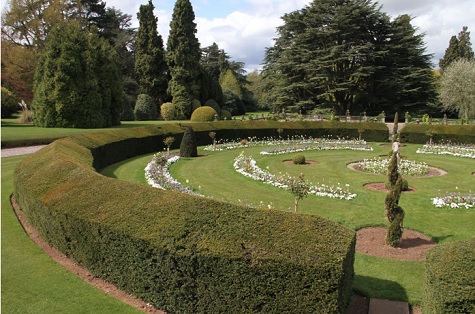
Outside the nesting season, between September and February, it is generally considered safe to cut hedges. However, you should always be mindful of local bylaws or regulations that may apply to hedge trimming in your specific area.
Please note that while these guidelines aim to protect wildlife, they may not be the only regulations or considerations relevant to hedge cutting in the UK. It's always a good idea to check with your local authorities or seek advice from wildlife conservation organisations to ensure you're in compliance with all applicable laws and best practices.

With the bird nesting season coming to an end at the end of August, many hedges will have put on some significant seasonal growth since they were last cut.
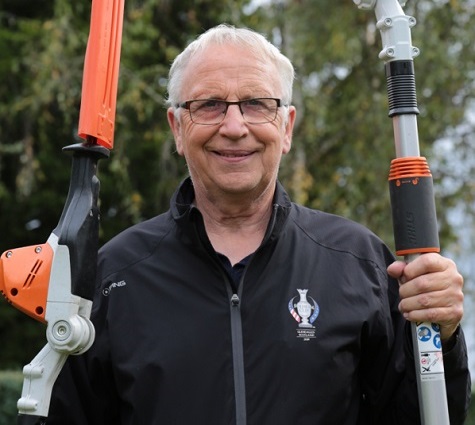
I, like many gardeners, will soon be busy catching up with the maintenance of many ornamental hedges. We are now blessed with a wide range of hedge cutting machinery, both petrol and battery powered, to undertake this work. I have, over the years, had the privilege to use both types of powered hedge trimmers.
Hedge usage
Hedges serve to keep stock in a pasture and out of crop fields. They also provide shade for stock and protection from the wind and guard against soil erosion. Hedges are an attractive feature of the British countryside and a valuable wildlife habitat, not just the hedge itself but also any associated ditch and bank. Hedgerows provide a rich source of food for birds and small mammals. They may also link otherwise isolated wildlife habitats thereby creating valuable corridors. Once planted, hedgerows require only periodic maintenance to provide a permanent barrier.
Popular hedgerow species include field maple, hazel, plum, crab apple, holly, sweet chestnut, elm, beech, hornbeam, ash, whitebeam, wild privet and spindle. Poisonous shrubs, such as yew and box, are not planted in stock hedges. Beech is not commonly found in farm hedges, since it is attractive to stock.
Both beech and hornbeam retain their leaves throughout the winter when managed as a hedge, shedding them only in spring, when emerging new shoots finally dislodge them, and it is this, along with their lush summer colour, that makes them so popular in gardens.
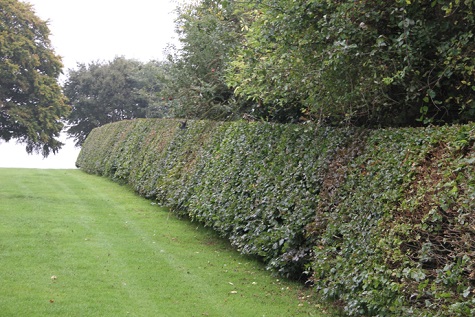
It was the plant collectors of the Victorian era who brought to this country a whole new variety of plant species that provided new material for landscaping and hedging in many of the Victorian parks and gardens. Over the years, these new species became very popular and widely used in all manner of environments.
Natural hedging and planting of trees on sports fields and golf courses has been popular for years, and there are many examples of old plantations - for example, a line of poplar trees being used to shield between fairways and tees. In the early 1970s, many parkland golf courses started planting conifer trees around greens and tees as they were fast growing and provided colour all year round. The same can be said for bowls clubs, schools and many parks who used hedges and trees, especially conifers, for screening purposes.
The popularity of hedges is that, not only do they provide a practical aid in creating barriers between properties and land assets, but they also offer an essential resource for wildlife.
Hedges support up to 80% of our woodland birds, 50% of our mammals and 30% of our butterflies. The ditches and banks associated with hedgerows provide habitat for frogs, toads, newts and reptiles.

Thick hedges with wide bases that provide plenty of cover are best, but there should be a variety of shapes and sizes from formal hedges to naturally developed stretches. Hedgerows with large numbers of woody species hold more birds. Trees, particularly oaks, support a rich variety of insects and are good song posts. Old trees have holes where blue tits, owls and kestrels, as well as bats, can nest.
Planting hedges can offer other benefits, both practical and ecological, including:
- Hedges can serve as windbreaks, helping to reduce wind speed and protect more delicate plants and structures from strong winds.
- A dense hedge can also help to mitigate noise pollution, providing a more peaceful and tranquil environment.
- The roots of hedging plants help stabilise soil and prevent erosion, especially on slopes and vulnerable areas.
- Hedges are living plants, and like all vegetation, they play a role in capturing carbon dioxide from the atmosphere, thus helping to mitigate climate change.
- Hedges can enhance the overall aesthetic appeal of an area, adding structure, texture, and greenery to the landscape.
- Instead of using artificial fences, hedges offer a more natural and aesthetically pleasing way to mark boundaries.
- Once established, many hedging plants require relatively low maintenance, making them a cost-effective landscaping option.
- Hedges can provide shade in hot weather, helping to cool down the surrounding area.
When selecting hedge plants, consider choosing native species that are well-suited to your local climate and soil conditions, as they will generally require less water and maintenance while providing better support for wildlife.
 |
|
 |  |
WEMBLEY LAYS AND PLAYS
New pitch technology used
In our first WEB ONLY story, the new hybrid carpet ‘Lay and Play’ grass pitch for the stadium was grown off site, on a turf farm hundreds of miles away.
NEW SPORTS TURF QUALIFICATION INTRODUCED
Turfcare Academy launched
In our next WEB ONLY story, a new international sports turf qualification for students who want to specialise in golf has launched.
RACECOURSE GROUNDSTAFF AWARDS '23
Open for submissions
The awards celebrate excellence in turf husbandry across British racecourses and are unique in that they remain the only dedicated awards for turf professionals within the sport.
The 2023 26th annual Racecourse Groundstaff Awards is now open for submissions.
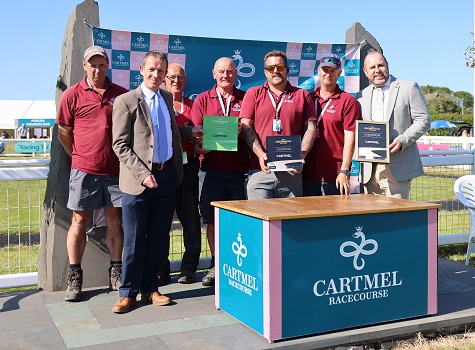
Winners of a previous award, staff of Cartmel Racecourse
New for 2023, the Richard Linley Award will reward the best newcomer to British horseracing. The Award is named in honour of Richard Linley, the former BHA Senior Inspector of Racecourses who recently retired after 35 years of service.
The organisers say the awards celebrate excellence in turf husbandry across British racecourses and are unique in that they remain the only dedicated awards for groundstaff within the sport.
The core Racecourse Groundstaff Awards celebrate the winners and runners-up across the three racecourse types: flat, jump and dual purpose. The winners of each category will go onto the RCA’s Showcase Awards on Thursday 23rd November at Aintree Racecourse where an overall Groundstaff Champion will be crowned.
Commenting on the awards, Holly Cook, racecourse services manager, said, “The Racecourse Groundstaff Awards recognise and celebrate the hard work, dedication and commitment of the groundstaff teams across British Racecourses, and are highly coveted and strongly contested by racecourses. 2022 saw the return of the awards for their 25th renewal, following a hiatus during the COVID-19 pandemic and all of the entries from racecourses clearly demonstrated the ongoing commitment to providing the best possible racing surface.
“The RCA is extremely grateful to our partners at Agrovista Amenity, DLF and Duralock for their support of the awards.”
 |  |
JUDGING PANEL ANNOUNCED
For GMA's awards
Ten judges have been tasked with selecting seventeen worthy winners from an industry-wide talent pool who, among them, represent every corner of the sector.
With the closing date to submit applications for the GMA Industry Awards today (14th August 2023), the Grounds Management Association has announced the judging panel for this year’s ceremony.

The ten judges have been tasked with selecting seventeen worthy winners from an industry-wide talent pool who, among them, represent every corner of the sector. Comprising of leading industry professionals, the stellar line up includes seasoned professionals, some with long and distinguished careers.
The 2023 judges include:
- Neil Stubley, Head of Courts and Horticulture at the All England Lawn Tennis & Croquet Club
- Adrian Kay, Head Groundsman at York Racecourse
- Meg Lay, Groundsperson at Gloucestershire County Cricket Club
- Lee Metcalfe, Senior Grounds Manager at Manchester City FC
- David Roberts, Director at Training Unlimited
- Anthony Facey, Area Sales Manager at Tuckwells
- Stuart Kerrison, Head Groundsman at Essex County Cricket Club
- Derek Walder, Operations Director at SALTEX
- Nasa Hussain, Head Groundsman & Facilities Manager at Yorkshire County Cricket Club
- James Wright, Senior Maintenance Manager at Leeds University
Derek Walder said, “To be invited to judge the Industry Awards applications this year is a real privilege. Having worked in the industry for over 56 years, it’s fantastic to be able to play a part in supporting the sector by recognising the hard work and dedication of those who contribute so much to maintaining the grounds they manage.
"I’m very much looking forward to the judging process, as well as attending the ceremony in November to celebrate the profound and often unnoticed achievements of the industry.”
Geoff Webb, CEO of Grounds Management Association said, “It’s wonderful to have received the support of such established industry professionals in helping us to shine a spotlight on the groundscare industry.
"Each judge comes with years of insight and invaluable experience from across all areas of the industry that will be put to good use when carefully considering applications and selecting our 2023 Industry Award winners.
"We look forward to welcoming the industry to Headingley Stadium this November to give a platform to those worthy of recognition.”
 |  |
NORTHAMPTON SAINTS PARTNER WITH MACHINERY MANUFACTURER
Five year deal
Agreement to supply agricultural and turf care machinery to Northampton Rugby Football Club at cinch Stadium.
Iseki UK & Ireland has announced that it has signed a five-year partnership agreement as official agricultural and turf care machinery supplier to Northampton Rugby Football Club at cinch Stadium at Franklin’s Gardens, Northampton.
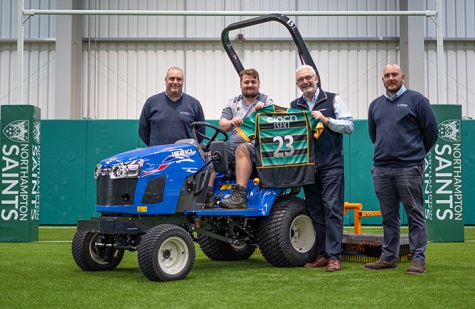
L-R: Anthony Shepherd, sales manager, Turney Group; Andy Miller, head groundsman NRFC; Alan Prickett, sales director Iseki; Simon Tunn, area sales manager, Turney Group
Under the agreement Iseki will supply tractors, mowing machines and electric vehicles to the club, for use by the grounds maintenance and stadium teams in their work around the site.
The partnership also covers manufacturer’s range of agricultural machinery, which will be showcased at events such as the annual ‘Farmer’s Day’ at the club.
David Withers, managing director of Iseki UK & Ireland said, “The opportunity to work with such a respected and long-established club is very exciting for both me and the team at Iseki.
"We have historically had a close relationship with England Rugby and now directly supporting one of the top rugby Premiership clubs offers us the opportunity to use the facilities at cinch Stadium at Franklin’s Gardens to showcase our machinery to both existing and prospective customers.
"We have supplied Saints with an Iseki TG6687 HST 67hp tractor with loader, which will be used for both on and off pitch work, one of our excellent SXG327 54” ride-on grass collecting mowers and a TXGS24 sub-compact tractor for use on the high-performance centre’s indoor pitches. Other products will be used by the club at various points in the year."
David continued, "Anthony Shepherd and Simon Tunn from our local dealer, P.A Turney Ltd., were extremely helpful in introducing us to Saints’ head groundsman, Andy Miller, and the rest of the management team at the Gardens, who share our excitement at being able to work together going forward.
"We will certainly be making extensive use of the facilities for both match days utilising our box, and for events and meetings at the Club in the future."
 |  |
FAUNAMASTER SEEDERS FIND NEW UK DISTRIBUTOR
Seed drills for use with ATV, UTV or tractor
The Faunamaster units, which come from Danish company Faunaseeds ApS, can sow seeds to a depth of up to 80mm.
Boss ORV have announced that they have been appointed as the sole UK distributor of Faunamaster Seeders.
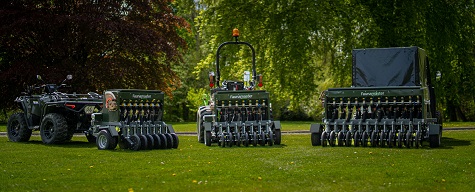
The units are described as multifunctional seed drills designed for use with an ATV, UTV or tractor. The Faunamaster, which comes from the Danish company Faunaseeds ApS, is said to sow seeds of virtually any size to a depth of up to 80mm. It is suitable for sowing into existing grass fields, wildflower meadows, tilled soil, paddocks or areas where normal planter equipment is too big.
The company says the seeder handles seed in many sizes, from small flower seeds to clover, alfalfa, beans, kale and corn, and can apply fertiliser at the same time as seeding. The capacity of the seedbox is 45 litres and the fertiliser box is 40 litres.
BOSS ORV, which is also the UK distributor of Corvus Off-Road Vehicles, say they will sell the Faunamaster through specially appointed dealers and their own UK dealer network. It will be shown on the BOSS/Corvus stand at the Groundsfest show at Stoneleigh in September.
 |
|
 |  |
THE FUTURE OF UNMANNED MOWING IS NOW
New Kress RTKn robot mowers
Mowers efficiently operate in parallel lines and autonomously move from an area to another, as if they were driven by humans.
The new Kress RTKn robot mowers extend unmanned mowing to larger areas. They efficiently operate in parallel lines and autonomously move from an area to another, as if they were driven by humans. No need for boundary wires, nor on-site antennas.

There are many applications that will benefit from Kress RTKn mowers, on any large turf area or extensive lawn. The RTKn is perfect for all larger properties, sports fields, golf courses, public parks - you name them. Unmanned mowing is the ideal solution for countless applications, providing quiet, emission-free turf management, with an operating cost that is a fraction of manned mowing.

Other robotic mowers that make use of RTK require the installation of at least one station antenna for each lawn, which needs to be powered and placed in open areas with an open sky. Kress RTKn delivers centimeter accuracy with no station antenna on site.
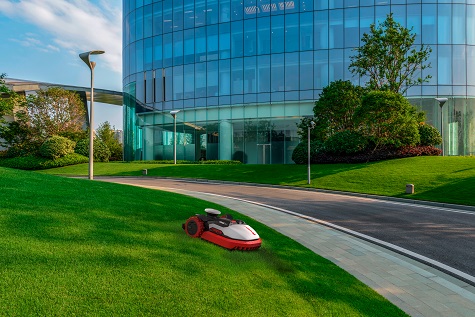
RTKn is different to others, as it gives positional accuracy to the power of network. To ensure centimeter-level accuracy, Kress’ expanding proprietary network of reference GNSS receivers continuously delivers RTK correction data to each mower via the mobile phone network.

The global navigation satellite system (GNSS) provides geo-spatial positioning with 2 to 5 meters accuracy, then real-time kinematic correction is applied to achieve centimeter-level accuracy. And even if there’s poor satellite signal, due to signals being blocked by buildings and trees, inertial navigation and odometry take over to precisely route the mower until it reaches an open sky area and satellite navigation is restored.
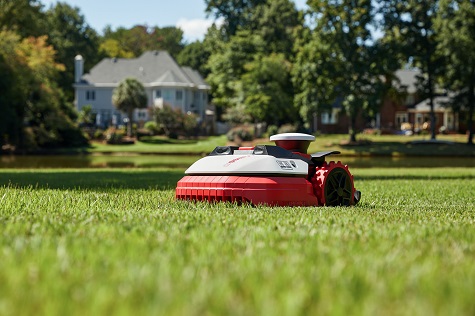
More benefits of RTKn include:
- Quick setup: Once a Kress dealer has mapped the areas and installed the charging station, you’re done − no on-site antennas installation needed.
- Zero emissions: No polluting exhaust fumes, no emission of greenhouse gasses.
- Quiet operation: Hotels can get their lawns manicured when customers are asleep, offices while people work, sports facilities at night while players rest and even educational institutions while people learn.
- Efficiency: The mower works in parallel lines, mowing large lawns as quickly as an experienced landscaper or groundsman like yourselves and your team. Leaving you to get on with other jobs.
- Operational savings: No labour costs, no grass cuttings to dispose of and minimal maintenance expense compared to combustion-engine mowers.
Visit https://www.kress.com/en-gb/ for more.
 |
|
 |  |
ADVERTISE YOUR JOBS HERE
Amazing success rates!
Advertise your recruitment needs on TurfPro Weekly Briefing and reach our targeted audience of recipients every week.
Contact Nikki Harrison for details - 01491 837117
|
 |  |
EDITOR'S BLOG ARCHIVE
Catch up with Laurence Gale's recent blogs
Want to catch up with one of editor Laurence Gale's blogs? Here is the place to do so.
TURFPRO FEATURE ARCHIVE
Find our previous features here
If you want to catch up with any of TurfPro's previous features, here is the place to do so.
TULIP TREE
Liriodendron tulipifera
LYDIA BROOM
Genista lydia
THE LAWN AND ITS VALUE
Changing attitudes
GIANT HOGWEED
Invasive and potentially harmful
LIFE-CYCLE ANALYSIS & SUSTAINABILITY
Considering every stage of the journey
NITROGEN USE EFFICIENCY
The most important nutrient
BERBERIS THUNBERGII
A shrub that has stood the test of time
ENSURING FUTURE PROSPERITY
Advice imparted at road shows
INNOVATION & SUSTAINABILITY
A key focus
PHOTINA RED ROBIN
A sensational flowering shrub
VALUING THE GRASSROOTS
We must not overlook those who maintain these grounds
MANAGING WEEDS SUSTAINABLY
In amenity spaces
DETECTING NUTRIENT DEFICIENCY SYMPTOMS
In turf plants
SPRING RENOVATIONS UNDERWAY
A crucial period
SUSTAINABILITY IN SUPPLY
A focus on those who supply essential inputs to our sector
CHANGING CLIMATE
Is a borehole the key for clubs?
SUSTAINABILITY AT THE SHARP END
How to put into practice when budgets are tight?
ANOTHER NAIL IN THE COFFIN OF GRASSROOTS RUGBY
Clubs are struggling
SUSTAINABILITY IN PRACTICE
Seeking transparent and robust supply chains is essential
TIME FOR ACTION
To reverse recruitment crisis
CONTROLLING COSTS
Planning is crucial
THE SEARCH FOR SUSTAINABILITY
What exactly does the term mean?
CARING FOR THE GRASSROOTS
From volunteers to contractors
DEFRA IS LETTING DOWN THE COUNTRY
Complete failure to address the plastic grass debate
WE CAN ALL DO MORE
To aid biodiversity
MY LIFE IN GREENKEEPING
With Bruce Cruickshank
LEVELLING UP, GETTING SMARTER & GETTING AHEAD
Parks require so much more funding
SWITCHED ON FOR HARD WORK
Putting trimmers through their paces
MACHINERY HIGHLIGHTS
At this year's show
MY SALTEX
Daniel Lewis, Manchester City Football Club
AWASH WITH LEARNING OPPORTUNITIES
Two months till showtime
LOOKING BACK, LOOKING FORWARD
Priorities for the amenity sector
THE DECLINE OF ‘PARKITECTURE’
A symptom of the state of parks in 2022
DEVELOPERS SHIRKING GREEN SPACE RESPONSIBILITIES
Lack of financial commitment
TIME TO COME TOGETHER
For the good of the industry
THE DEATH OF GRASS ROOTS CRICKET
Gathering apace?
ROUTES INTO THE INDUSTRY MUST BE ENSURED
Q&A with David Fisher, Lantra’s head of industry partnerships
STRONG VIEWS ON CRICKET PITCH PERFORMANCE MARKING
A bone of contention
A PREMIUM PRODUCT
Delivered at Naas Golf Club
THE GREEN REVOLUTION
And Esker Hills
MAKING A CHANGE
Laytown and Bettystown Golf Links
A DAY AT THE RACES
Naas Race Course
WORKING TOGETHER AS ONE VOICE
How the industry needs to proceed
OVER 175 YEARS OF EDUCATION
Wesley College
ELECTRIC EXCITEMENT
Dennis's Ian Howard talks electrification
THE HOME OF CORK GAA
Páirc Uí Chaoimh
LONG POLE BATTERY HEDGE TRIMMERS TESTED
STIHL HLA 66 and HLA 86
OVER 800 YEARS OF HISTORY
Johnstown Castle and Gardens
A CLUB GONE WILD
Kilkenny Golf Club
A GOLF COURSE IN THE GARDEN OF IRELAND
Woodenbridge GC
80 YEARS YOUNG
Charleville Golf Club
AN UPLIFTING EXPERIENCE
Bunclody Golf & Fishing Club
GETTING BACK TOGETHER
Albeit gradually . .
GO WEST
Inishturk GAA pitch – one of the most westerly sportspitches in Europe
WORKING ON A TIGHT BUDGET
Nenagh Golf Club
ON A MISSION
Wrekin Golf Club aiming to enrich wildlife and fauna
WILD AND WONDERFUL
Design By Nature
LEARNING HOW TO SURVIVE
Abbey Par 3
TACKLING OBESITY
Vital that schools can provide sport
A LIFETIME OF LEARNING
Vital for turf professionals
CELEBRATING 125 YEARS
Tullamore Golf Club
UNIVERSITY CHALLENGES
At Trinity College Dublin
BLENDING THE OLD WITH THE NEW
Bray Golf Club
A WELL POLISHED COURSE!
Ierne Social And Sports Club
IDENTIFYING THE TRUE VALUES
Of grounds maintenance
THE INDUSTRY WILL CHANGE & ADAPT
But it will survive
WIRRAL GOLF COURSES SAVED
Renewed hope and optimism for the future
GREEN SPACE CONTRIBUTION TO WELLBEING IS UNDERVALUED
Parks invisible on national agenda
A SHINING LIGHT IN IRELAND'S SUNNY SOUTHEAST
Wexford Golf Club
GREEN SPACES DO NOT LOOK AFTER THEMSELVES!
Keith Kent says we must invest in people
WE SHOULD TELL THE WORLD ABOUT THE UK INDUSTRY
Right time for all sides to come together
SOIL LIFE IS PRECIOUS
Good-quality soil can help save the planet
MORE THAN JUST CUTTING GRASS
Encouraging the next generation
A BUZZ FROM DOING THE JOB
Wide experience of the turf grass industry
PAYING THEIR WAY
Low wages is the bane of the industry
AMENITY MANAGEMENT IMPACTS US ALL
Professor John Moverley
CARING FOR PARKS OF ALL TYPES
Mary Worrall
TOP FIVE FRUSTRATIONS FOR CRICKET GROUNDSMEN
What causes you the most frustration in your role?
PROFESSIONALS AT THE CUTTING EDGE
Vic Demain and Phil Sharples
BOWLS CLUBS IN PERIL
A sad decline
A VERY SPECIAL INDUSTRY
Loz looks back
SNEAK PEAK AT A ROBOTIC "GAME CHANGER"
Commercial model capable of covering 50,000 m2 teased
HALESOWEN PICK A BIG ROBOT UP FRONT
Invest in mowers
COMPRESSED AERATION
The new way
PARKS MATTER MORE THAN EVER
Recent sector developments
ON TEST
STIHL blowers
THREE CORE VALUES TO SHAPE OUR INDUSTRY
Real concerns for the future
ENGLAND'S GREEN SPACE GAP
A split along racial lines
ON TEST
EGO STX3800 strimmer with RTX2300 Rotocut head
A SECTOR FACING IMPORTANT TIMES
Review of the National Action Plan
PARKS MATTER
The role of public parks in the recovery: a discussion paper
A UNIQUE SPORTING VENUE
Wormsley private estate
A BTME OUTDOORS?
A good bet for the industry
PARKS NEED APPROPRIATE POLITICAL REPRESENTATION
Q&A with Philippa Reece, Parks and Foreshore Manager at Adur and Worthing Council
CRICKET LOAM
What does it mean?
A HERCULEAN EFFORT TO GET PARKS BACK TO NORMAL
Q&A with Chris Worman, Rugby Borough Council’s parks and ground manager
ON TEST
STIHL battery products
TURFGRASS STRESS MANAGEMENT
Reactive Oxygen Species (ROS) and antioxidants during biotic and abiotic stress in turfgrass plants
AUTUMN DISEASE MANAGEMENT
The coming months are going to prove very difficult
THE ABUSE OF PARKS . .
Is the abuse of society
WHY PARKS MATTER?
A statement from the Parks Management Forum to the Prime Minister
THE 21st CENTURY PARKS MANAGER
Innovative, creative and entrepreneurial
EAT, SLEEP, CUT, REPEAT!
Cricket under covid
TIME FOR A SINGLE SHOW?
Debate brought back into focus
A CHALLENGING TWO MONTHS
Running golf design projects from home
PRESSURE SITUATION
Cementing the reputation
A CLUB TO BE PROUD OF
10 years at the helm of Olton GC
GAME CHANGERS IN TURFCARE
The day the Lord's outfield reconstruction proved its worth
THE ESSENCE OF ESSENTIAL
Finding a sensible way forward on defining "essential maintenance"
THAT WAS THE YEAR THAT WAS
2001
HOW TO LOOK AFTER A GOLF COURSE WITH NO GOLFERS
Fundamental to the survival of almost all courses, if not of the game itself
RAIN STOPPED PLAY WOULD BE WELCOME
. . along with ‘lunch is being taken early’
PHYSICAL CONTROL OF TURFGRASS PESTS
An urgent problem
A DIVERSE & ENTERTAINING WEEK
Successful BTME 2020
INTEGRATED PEST CONTROL
Opportunity to embrace new methods
ENVILLE ON THE UP
Major investments taking place
GREEN FLAG AWARDS 2019
A great success
U.S PROFESSIONAL EQUIPMENT SHOW EXCELS
Buoyant GIE+EXPO
LEGACY OF THE SOLHEIM CUP
At Gleneagles
A DAY OUT WITH THE LADIES
Behind the scenes at the Solheim Cup
COVENTRY UNIVERSITY'S EDIBLE GARDEN SUCCESS
2006 - present
HAIL THE GRASS MASTERS!
Boorish media comments about pitch quality are wide of the mark
CONTRACTOR SEES MULTI-DISCIPLINE SUCCESS
360 Ground Care serving professional facilities
BUSY TIMES
Judging the Green Flag Awards
TAKING AN INTEGRATED APPROACH
What does it all mean in managing turf surfaces?
UNDER PRESSURE
Dry weather conditions continue to keep turf managers focused on moisture management
EDDIE SEAWARD
Death of Wimbledon’s influential grounds manager
MAJOR NEW IRRIGATION PROJECT
At Top 100 classic Berkhamsted Golf Club
NEW HORIZONS FOR THE HATTERS
Investment paying off at Kenilworth Road
ELIZABETHAN RESTORATION
At Castle Bromwich Hall Gardens
WHAT IS BIOPHILIA?
The vital impact of parks and green spaces on health and well-being
WORM CONTROL
Without carbendazim
THE TRUE COST OF PETROL
Battery-powered outdoor power tools are now turning the heads of professionals
SANDS OF TIME
Sand-based pitches are now the norm in professional sports
WHY DO WE DO THE RIGHT THING?
We must maintain industry standards
CHASING GRASS PERFECTION?
11 things you need to know . . .
MAINTAINING STANDARDS
Q&A with BASIS ceo, Stephen Jacobs
STRI RESEARCH DAY 2018
Hosted at research trial grounds in Bingley
THE MECHANIC
Leicester City FC invest in new role
LORD'S 'GRASS-GUVNOR' TO RETIRE
Mick Hunt bows out after 49 years
HOLLOW CORING & DEEP SCARIFICATION
Is it really necessary?
 |
|
 |  |
 |  |
 |  |
 |  |
SUSTAINABILITY – IMPLICATIONS FOR TRAINING & EDUCATION
Set to play a crucial role going forward

Sustainability in education, skills training and continuing professional development (CPD) is vital, both in terms of updating for existing staff and for new entrants.

In the first of this series of articles, we sought to get a clearer definition of what sustainability is and what it means to an organisation, especially in the amenity horticulture sector. Sustainability comprises three pillars or components namely economic viability, environmental protection and social equity. The definition of these is important when any organisation seeks to become more sustainable, or indeed seeks to deliver more sustainable products and services to its customers. The remaining articles on this subject will now look more closely at various sub sectors of, and activities in amenity, and those providing services to them which hopefully will help all readers in their own search for sustainability. Previously we considered Sustainability In Practice, Sustainability At The Sharp End, Sustainability In Supply, Managing Weeds Sustainably, Innovation & Sustainability and Life Cycle Analysis and Sustainability.
This month we focus particularly on the area of skills and education in terms of achieving better sustainable practice.
Over previous articles, we have looked at examples of sustainable practice and how small changes can make a real difference. We have reviewed how organisations across the amenity sector are seeking to adopt more sustainable practice and looked at developments in research and innovation. There is much to learn, and education, skills training and continuing professional development (CPD) is set to play a crucial role going forward, both in terms of updating for existing staff and for new entrants.

We are in a very changing and challenging world. External pressures, both economic and in other ways, are requiring different approaches to be adopted. In pest, weed and disease management for example, the emphasis now is on integrated approaches with established practices needing to adapt to new methodologies, technologies and products, as well as the loss of certain plant protection products. Those already working in, and those seeking to enter the sector, will require this change to be reflected in education, updating and training opportunities and requirements.
Organisations such as Lantra are already very much on the case in terms of their existing training materials and qualifications. They have commissioned external specialists to review both existing qualifications and learning materials across the board, in preparation for re-writes as needed to better reflect sustainable practices and objectives. They have also engaged in discussions with providers, seeking to identify new qualifications that might be needed, relating to national sustainability goals and changes in practice already being adopted in the sector. Reflecting changing ways of learning, they are looking at increasing the number of bite size courses on topics such as, for example, establishing and maintaining green rooves, and in assisting organisations in analysis of processes and supply chains (life cycle analysis) to improve sustainably in their practices. They see sustainability not as a separate subject, but integral to all they seek to deliver and assess within their qualifications offer and support to the sector.

Driving forward with education and training also needs to attract new people into the sector. In that regard, Lantra has recently launched a new online careers resource that aims to help tackle a shortage of skilled workers in landbased and environment industries. By providing detailed information about the wide variety of careers, Lantra seeks to attract new talent from a more diverse range of backgrounds, helping the industry to flourish and meet a rising demand for creators and stewards of the nation’s green spaces, The goal is to break down the barriers to attracting new entrants and providing the workforce with the right tools and training it needs to hone skills and develop careers. This will be achieved by engaging with businesses and local authorities to understand which common operational skills are most lacking, preventing overall service delivery.

In terms of education, City & Guilds are leading on the development of newly introduced T levels and these too seek to fully reflect sustainability considerations in both design and implementation. T Levels are 2-year courses which are taken after GCSEs and are broadly equivalent in size to 3 A Levels. These courses have been developed to meet the needs of industry and prepares students for entry into skilled employment, an apprenticeship or related technical study, through further or higher education. T Levels offer students’ practical and knowledge-based learning at a school or college, and on-the-job experience through an industry placement. Looking forward, such students will be seeking employment, and, along with the vital skills needed both practically and in knowledge gained, being able to ensure sustainable practices are always key to actions will be vital.
BASIS Registration is a well-established and respected organisation in our sector, it also seeks to ensure that, in delivering or assessing training, sustainable practice is a fundamental part of the process. They too have reviewed all their existing processes and their wider offer, to ensure that they reflect sustainable practice. They have developed innovative training materials using their digital learning platform, BASIS Classroom. Currently, as part of this offer, they have a course focussing on sustainable practice in agriculture and, under development, is a similar one for the amenity sector. The courses within Classroom include assessment and are fully recognised as continuing professional development programmes.
As a senior member of the BASIS team says ‘In considering the need for sustainable practice and meeting net zero targets as a nation, we must not forget the three pillars include economic. If we are to drive forward with sustainable practice it must be economically viable. Sustainability is not a subject on its own but part of what we do as best practice’
Recently the European Commission adopted a recommendation for learning for sustainable development. Within it was stated ‘ Education and training must respond to the challenges and realities of the 21st century, meet learners’ needs and help them to deal with changing challenges in society and the workplace. To equip learners with the competencies needed to shape a more sustainable economy and society, learning programmes need to be transformative and interdisciplinary.’
This may seem somewhat management speak but demonstrates that the sustainability agenda is not just in the UK but global, something to be picked up on in a future article in this series. Economies in many countries are under stress and organisations are struggling to adapt to new national agendas whilst remaining profitable and delivering customer expectations. Delivering education and training to reflect this change, and in new and exciting ways, will be vital.

Membership organisations such as the British Association of Landscape Industries (BALI), the Grounds Management Association (GMA) and the British and International Golf Greenkeepers Association (BIGGA) all put great emphasis on updating and providing such opportunities against a background of sustainable practice. At the last SALTEX event organised by GMA, sustainability was a key theme both in the demonstrations, on the stands and in the learning opportunities offered. A similar thing can be said for the last BTME event organised by BIGGA. The author of this article has also recently spoken at the Sports and Grounds Exhibition where sustainability and ways of developing sustainable practice were fully at the core of the event.

However recognising the complexity of the subject, again the emphasis must be on taking small steps. Wayne Grills, from BALI, says his organisation has established a task and finish group seeking to ensure clarity of message to their members built upon a practical and workable strategy. Like other organisations, in its own operations, it has sought to adopt more sustainable practice but it recognises the complexity of the topic and the need to have clear and concise messaging to members who then, in turn, can seek to adopt them in their own organisations. As he puts it in a landscaping context, not only do we need to plan and develop more sustainable spaces and structures, but these need proper ongoing maintenance as , if not, the expected outcomes for sustainability will not be met. Wayne also emphasises the importance of life cycle analysis in determining sustainable practice. Whatever is done must be practical or else we are in danger of greenwashing.
The availability of skilled labour is an ongoing challenge for the amenity sector. The need is twofold; firstly a need to attract and train new entrants with the right skills. Secondly there is a need to develop on-going training provision for those already in the sector. Again it must be emphasised that we do not need sustainable practice as a separate subject but to be considered in all current practices if it meets the criteria of the three pillars of sustainability. Developing training programmes and emphasising the importance of continuing education and professional development are crucial for ensuring a future workforce that can effectively address the evolving needs of the industry.
Learning is a lifelong process of growth and development. It can empower us to become empathic individuals, build our self-confidence, learn more about our strengths and address our weaknesses. It makes us better as people and in the work we undertake. Never as it been so important for all organisations to ensure their staff have the necessary skills and access to CPD in order to undertake their roles effectively and efficiently. They must invest in giving the time for existing workers to keep abreast of developments. This is certainly the case for sustainable practice.
A quote, I very much like, to end this current article comes from Sydney Harris and is ‘The purpose of education and ongoing professional development is to turn mirrors into windows’
The next article in this series will seek to provide a more global perspective of sustainability, how others are addressing the issue, and examine the implications for all who are involved in our vital and essential amenity sector.
 |
|
|
|